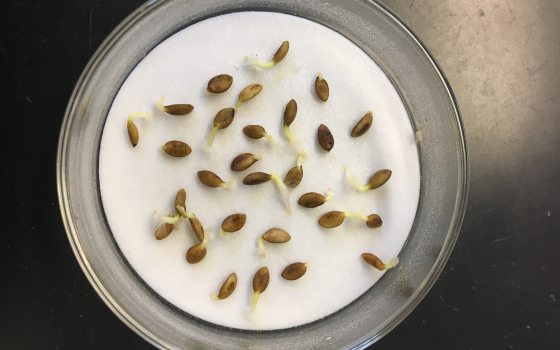The Meadow Garden at Longwood is a beautiful space that helps to inform visitors about native and naturally producing flora throughout the seasons. The Meadow Garden also illustrates how native plants can be used in our own gardens both for aesthetic benefit and wildlife habitat. Each habitat in the Meadow demonstrates the complex interrelationships of plants, insects, birds, amphibians, and many other small animals. Sadly, in recent years the beloved monarch butterfly (Danaus plexippus) has been in decline due to habitat destruction. The good news is we can work to reverse this trend in our own gardens.

The beautiful monarch butterfly is considered to be the king of the butterflies. These extraordinary insects travel up to 3,000 miles each fall to their wintering sites in Mexico and California. The monarch migrates for two reasons: it cannot survive the freezing weather in the north, and its food plants do not grow during the winter season. When monarchs visit our gardens in the summer months, many people are unaware of their interesting life cycle.
The monarch's complex life cycle has four stages: the egg, the larva (caterpillar), the pupa (chrysalis), and the adult butterfly. There are actually four generations within a year that complete the whole cycle. After migrating north in March or April the butterflies lay eggs on native milkweed plants, which the baby caterpillars continuously eat in order to grow strong. After about two weeks the caterpillars will attach themselves to a stem or leaf using silk to form a chrysalis. This process is called metamorphosis, during which the caterpillar turns into a beautiful butterfly.

The fourth and final generation of the summer is slightly different from the previous generations, as the butterflies migrate south to warmer climates. They'll hibernate for a number of months in Mexico and California, until the next year when the whole process begins again. This is a fantastic example of how wonderful and complex nature can be. The migrating monarchs hibernate on the same host trees as their predecessors, which seems incredible because they are completely different butterflies from the previous year.
With habitat loss it is becoming important to protect this butterfly’s survival. Monarch larvae (caterpillars) only feed on native milkweeds (Asclepias spp.), which are perennial plants. This means the plant will come up year after year from rootstock below the ground. Gardeners can do their bit to save this beautiful butterfly by selecting milkweed species that are native to their region. The plant can be propagated by seed, cuttings, or division. Milkweeds are known for being a very diverse group of plants and are found throughout the Americas.
Here at Longwood the Meadow Garden contains common milkweed, butterfly milkweed, and swamp milkweed. Over the past few years we have been boosting the already established populations. We have also been working to introduce new species of milkweeds that are native, but not common, to our area: whorled milkweed, purple milkweed, and poke milkweed. Tropical milkweed from the south should not be grown as it can keep flowering throughout the winter, which encourages the monarchs to linger instead of flying south. Studies have also found that tropical milkweed can transmit a nasty parasite to the butterflies. This again highlights the importance of planting only native regional milkweeds.

One interesting process carried out in the Longwood Meadow Garden is the mowing of milkweed in certain areas in early June. Milkweeds are known for being tough and quick to regrow. Cutting back delays the flowering until later in the summer. This provides late summer nectar and the caterpillars find the new leaf growth more palatable. Fully grown monarch caterpillars have no problem eating the tough leathery leaves of the milkweed. However, newly hatched caterpillars can’t break it down and digest it.
Monarchs are iconic American butterflies, as well as an important part of our global biodiversity. Their fascinating migration from Mexico across the United States is a truly unique phenomenon. The plight of monarchs brings awareness to the health of our natural landscape and its pollinators. Monarch decline is demonstrative of the environmental problems that pose a risk to food production and the overall health of our planet. Every garden, school, business, community group, and private land owner can help by planting native milkweed and protecting monarch species for future generations.
Bring friends and family and Meet Us in the Meadow for A Pollination Celebration on June 25, 2016, from 4:00–8:00 pm.
National Pollinator Week is June 20–26, when organizations across the country highlight and share the importance of pollinators, including bees, birds, butterflies, and bats. Pollinator Week was initiated and is managed by the Pollinator Partnership. Learn more at www.pollinator.org.


